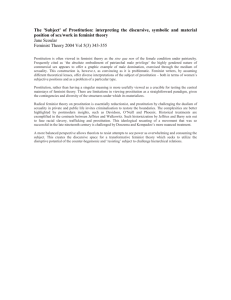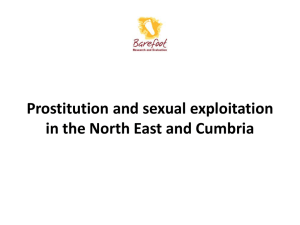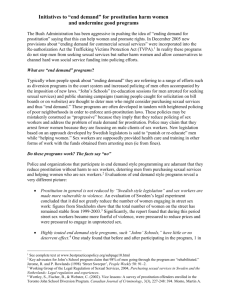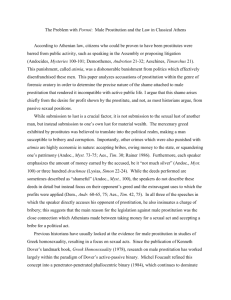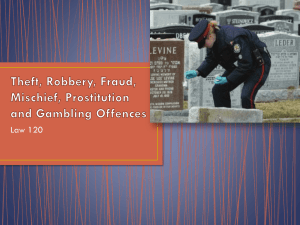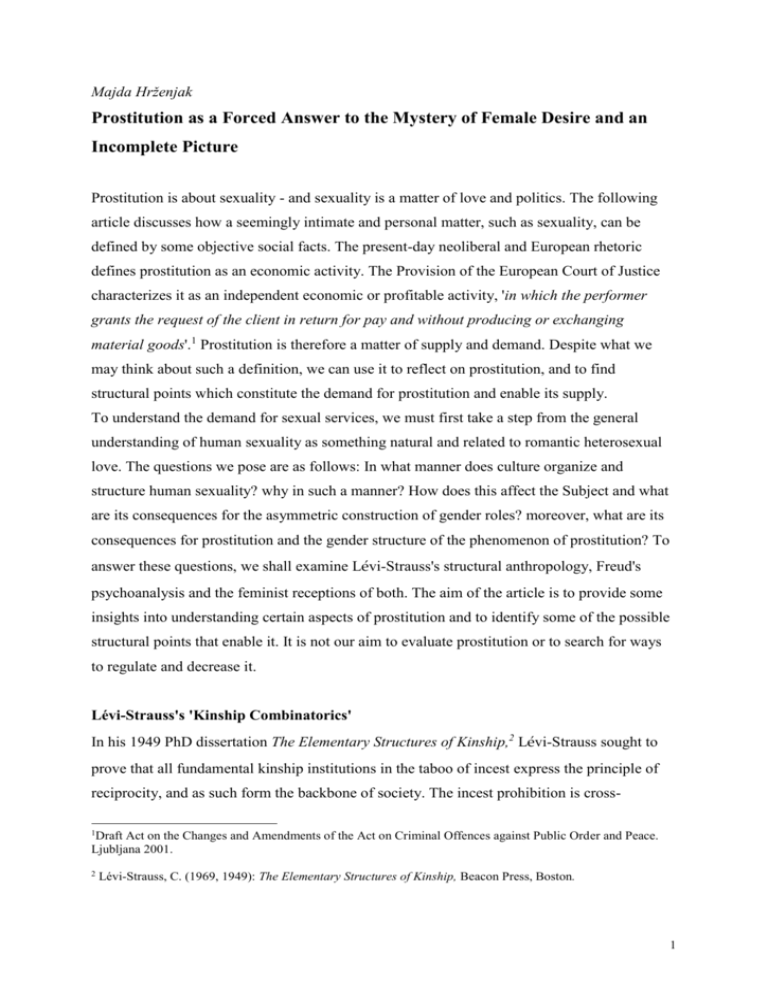
Majda Hrženjak
Prostitution as a Forced Answer to the Mystery of Female Desire and an
Incomplete Picture
Prostitution is about sexuality - and sexuality is a matter of love and politics. The following
article discusses how a seemingly intimate and personal matter, such as sexuality, can be
defined by some objective social facts. The present-day neoliberal and European rhetoric
defines prostitution as an economic activity. The Provision of the European Court of Justice
characterizes it as an independent economic or profitable activity, 'in which the performer
grants the request of the client in return for pay and without producing or exchanging
material goods'.1 Prostitution is therefore a matter of supply and demand. Despite what we
may think about such a definition, we can use it to reflect on prostitution, and to find
structural points which constitute the demand for prostitution and enable its supply.
To understand the demand for sexual services, we must first take a step from the general
understanding of human sexuality as something natural and related to romantic heterosexual
love. The questions we pose are as follows: In what manner does culture organize and
structure human sexuality? why in such a manner? How does this affect the Subject and what
are its consequences for the asymmetric construction of gender roles? moreover, what are its
consequences for prostitution and the gender structure of the phenomenon of prostitution? To
answer these questions, we shall examine Lévi-Strauss's structural anthropology, Freud's
psychoanalysis and the feminist receptions of both. The aim of the article is to provide some
insights into understanding certain aspects of prostitution and to identify some of the possible
structural points that enable it. It is not our aim to evaluate prostitution or to search for ways
to regulate and decrease it.
Lévi-Strauss's 'Kinship Combinatorics'
In his 1949 PhD dissertation The Elementary Structures of Kinship,2 Lévi-Strauss sought to
prove that all fundamental kinship institutions in the taboo of incest express the principle of
reciprocity, and as such form the backbone of society. The incest prohibition is cross1
Draft Act on the Changes and Amendments of the Act on Criminal Offences against Public Order and Peace.
Ljubljana 2001.
2
Lévi-Strauss, C. (1969, 1949): The Elementary Structures of Kinship, Beacon Press, Boston.
1
culturally universal, i.e. present in all cultures, albeit in a variable way, since it is expressed
differently in every culture. For instance, in some cultures a man is ordered to sleep with his
sister but prohibited to sleep with his seven times removed cousin. In a different culture, the
incest prohibition means a prohibition for a man to sleep with his sister but an order for her
mother's brother, i.e. her uncle, to deflower her before her marriage. The incest prohibition is
commonsensically thought to be natural: nature is supposed to prevent the same genetic
material from mixing since this would lead into the deformation of the species. Yet, if the
incest taboo were the consequence of a natural law, the same rule would apply for all cultures,
and would refer to an aversion to sex with one’s genetically closest relatives. Anthropological
field studies provide an abundance of evidence to the contrary.
Even before Lévi-Strauss, Marcel Mauss in his work The Gift 3 described the principle of
reciprocity as a total social fact, on which integration and solidarity between individuals and
social groups are based. Lévi-Strauss interpreted the Mauss reciprocity principle through the
anthropological concept of the law of exogamy. This law, as stated by Lévi-Strauss, does not
refer only to the obligatory marriage outside one's clan,4 but also to the prohibition of sexual
intercourse with one's mother, daughter and sister, because these women are to be given into
marriage to another man. Subsequently men acquire the right and access to other women. The
other side of the coin of the law of exogamy is therefore the taboo of incest, which is more of
a requirement for a reciprocal exchange of women between two groups of men than a
prohibition for men to sleep with their female relatives. Compared to exchanging material
gifts, the gift of exchanging women, a ritual in traditional societies,5 has more radical
consequences because it does not only establish the relations of reciprocity but also familial
relations. The result of the prohibition of incest is the division of the totality of possibilities of
sexual choices into two categories: the category of prohibited sexual partners, and the
category of allowed sexual partners. Consequently the prohibition of incest also means the
domination of the social aim of exogamy over biological sexuality.
3
Mauss, M.(1996): Esej o daru in drugi spisi, Studia Humanitatis, Ljubljana.
4
The same was claimed by some of the anthropologists who studied this principle of social structuring before
him. Tylor, for instance, concisely described its function as 'marry out or be killed out', which means that the
function of the exogamous principle is the formation of alliances among various groups.
5
Perhaps the most widely known such rituals are kula and potlatch. More in: Hrženjak, M. (2002): Simbolno,
Študentska založba, Ljubljana.
2
By postulating a theory of the prohibition of incest as a foundation of culture, Lévi-Strauss
also brought to the fore the importance of sexuality and the division of humans according to
their gender as a structuring principle of culture.6 He defined some general rules of
organization of human sexuality, which simultaneously serve to establish and maintain culture
and cultural order. These are: the incest taboo, obligatory heterosexuality and asymmetric
distribution of gender roles (the male being the subject, the gift-giver, active; the female being
the object, the gift, passive).7 These three principles function in contemporary societies as
well. Arranged marriages may be rare nowadays – they exist only in certain circles but more
for endogamous than exogamous reasons (maintaining a certain status, accumulating
property, capital and the like) – however a kind of mating combinatorics, as we shall show in
the following sections, still exists.
Sexuality and Love
If we look at these concepts from a different, more experiential point of view, the question
arises whether sexuality and love are one and the same thing. Do we really sleep with the
people we love? Even though we would like to give an affirmative answer to this question, a
more careful consideration inevitably leads to a negative one. An obvious example is
prostitution, in which love and sexuality are separated, since the act between the prostitute
and the client is usually a loveless sexual act. The following examples, however, prove
otherwise. For instance, we love our parents, children, friends, (sometimes) teachers, but we
do not sleep with them. The unwritten cultural rules and taboos allow us (or even prescribe to
us) to love the ones close to us, but prohibit us from sleeping with them. On the other hand,
they prohibit us from loving a prostitute, but allow us to sleep with them. This means that
culture, through taboos and prohibitions, makes love and sexuality completely incompatible,
and that it is sexuality that is problematic. No one is interested in who we really love – this is
an intimate matter, which has no wider social consequences. However, if our love is also
consummated, matters become seriously complicated and have certain consequences. With a
hint of exaggeration, it can be said that every time we sleep with an available partner, we are
reinforcing the existing social order, and every time we sleep with a prohibited partner, we are
disrupting the existing social order in the sense of rending certain established social relations
and social networks. In order not to disrupt this order to a too large an extent – which can be
For more cf. Gayle, R. (1975), The Traffic in Women: Notes on the ‘Political Economy’ of Sex, in Rayna R. R.
(ed.) Toward an Anthropology of Women, Monthly Review Press, New York, London, pp. 157 – 211.
7
Also understood in this light could be the odd custom of the father giving away his daughter to another man,
his future son-in-law, but never giving away his son.
6
3
rather tiring – it is perhaps safer and more rational to go to a prostitute. A prostitute is in most
cases not a part of the client's social network, therefore, a sexual act with a prostitute has no
wider consequences, especially if the affair remains a secret. In the sphere of prostitution,
anonymity and discretion are guaranteed; secrecy is a common characteristic of prostitution.
Both the prostitute and the client remain anonymous.
On the other hand, culture (in principle and a priori) unites sexuality and love in wedding,
marriage and partnership. Marriage actually means that we leave the circle of the ones close
to us, the ones we love but are not supposed to sleep with, and find someone virtually among
strangers, someone whom we are able to sleep with and love at the same time. As a rule, this
partnership is heterosexual, exclusive (we are allowed to sleep with and love this one partner
only), long-term and centred on reproduction, i.e. the procreation and the upbringing of
children. A difficult task, which very often fails. The requirement to choose only among
heterosexual partners, who are also to be exclusive and long-term ones, results in sexuality
becoming a relatively rare commodity since all other partners become unavailable to us and,
at the same time, once in a partnership, we become a prohibited object for others. In relation
to human sexuality, a prohibition is constitutive, it enables and encourages it. This fact may
explain the testimonies of prostitutes about their most frequent clients being happily married
men.
Sexuality is therefore a rare commodity, and as such it is in great demand. And, as they put it
in the marketing jargon: where there is demand, there will be supply. The fact that procreation
is an important function of partnership can make sexuality rather monotonous since it narrows
the choice of otherwise possible sexual practices. The variety of sexual practices is once again
a market niche filled by prostitutes. They claim that after happily married men, the most
frequent clients are individuals who are unable to find a sexual partner for specific types of
sexual practices.8 Furthermore, clients can be found among foreigners physically separated
from their partners, and those who have, for some reason, been excluded from the 'kinship
combinatorics' or have made a conscious decision not to enter it.
In this way, prostitution really is the other side of the coin of the law or marriage. But not
because monogamy is unnatural or because long-term partnerships kill sexuality, as is
commonly believed. It is because the systems of marriage not only limit the choice of sexual
8
For instance, domination, S/M practices, homosexuality, various fetishisms and similar.
4
partners (no relatives, outside of some close social relations, heterosexual choice of partners,
and so on) but also narrow the universe of possible sexual partners (those already married are
prohibited). In addition, any violations of the rules regulating sexuality – these rules are
mostly a part of relatives systems, i.e. the systems of marriage – bring about a destabilization
of the individual's whole social network.
The question that arises here is why it is predominantly men that contribute to the demand for
prostitution as a rare commodity. Why do women do it to a substantially lower degree? Why
is there no demand for male heterosexual prostitution? According to the rules of 'kinship
combinatorics', both genders are in a similar, unenviable situation. How do we then explain
the gender structure of the phenomenon of prostitution, which also manifests itself as an
incomprehensible characteristic in the light of the declarative freedom and equality of sexes in
contemporary societies? Despite the increase in child, transvestite and male prostitution (the
latter for predominantly male clients), it is still possible to claim that the supply of sexual
services is provided mostly by women, while the demand for sexual services and the
organization of the larger part of the sex industry is mostly in the domain of men. Why is
prostitution gender-structured? Why do men not decide to enter the sex trade in greater
numbers and why do women not appear as clients or consumers of sexual services in greater
numbers?9
Freud's Description of Female Sexuality and the Mystery of Female Desire
On the basis of Freud's psychoanalysis, some possible answers to the question why there are
no women on the demand side of prostitution can be derived. Freud's psychoanalysis can be
described as a theory of reproduction of relatives systems on the level of the individual, and as
a testimony to what consequences are borne by the individual facing the rules regulating
sexuality in their society. Psychoanalysis is also a theory about the way the androgynous
human young are transformed into boys and girls, men and women. Without going into too
much detail, it can be said that relatives systems demand a division of gender roles and that
9
It would seem that the commonsensical explanation of prostitution, which searches for its motives in the nature
of male sexuality, which is supposed to be uncontrollable and polygamous (men need more sex with various
sexual partners), does not apply. The purpose of prostitution is to serve this explanation, which makes it socially
functional since it protects married and other women, and also children from the exaggerated appetites of male
sexuality, which could, if unsatisfied, lead to sexual abuse and rape. If the male sexual drive is really so
insatiable, then the male sexual constitution could be considered ideal for the occupation of a prostitute.
However, this solution, even if men wanted it, is not viable because there is no demand for male heterosexual
prostitution.
5
they contain a series of rules and taboos that regulate sexuality. Freud's famous concept of
Oedipus complex analyzes the division of gender roles and the assimilation of rules and
taboos regulating sexuality that apply for relatives systems. What we like to call 'compulsive
heterosexuality' in feminism,10 is considered to be the final product of these processes.
To simplify, within the Oedipus complex, the child absorbs the social regulation of sexuality
on two levels: on the level of object choice and on the level of erogenous zones organization.
The points of highest sensitivity on the body of a small child are not yet organized into
erogenous zones, so the child's body is full of sensations, sensitivity and pleasure, which
manifests itself as discomfort. The disciplining of the body, which occurs in the processes of
socialization, leads to the command of these sensations, their localization and focusing. The
sensitivity and pleasure are completely removed from a large part of the body, however they
remain located mainly in the erogenous zones, mostly in the parts of the body that have a
procreative function. During this process something occurs that relocates sexuality from the
body to the mind. As someone once said, the brain is the most important erogenous zone:
merely thinking about a garter on a woman's leg, for instance, becomes more sexually
stimulating than an actual physical point on the body. Prostitutes know this all too well, and
are thus appropriately clad.
The primary object for children of both sexes and at the same time the object of imaginary
identification is the mother. This object, which also functions as a sort of a primary matrix for
all other choices of sexual objects, is non-functional since it is incestuous and since the object
is in most cases no longer available. With girls, an additional problem arises: the initial object
choice is a homosexual one. This is the reason why the child must abandon the primary
object.11 Freud wrote extensively about the traumatic nature of this abandonment, which does
not occur on its own as a result of some natural, automatic psychological maturation but under
the external pressure of the process of socialization.
With boys, the core of this pressure is centred on the transition from the primary imaginary
identification with the mother into the symbolic identification with the father. The object
choice pressure must above all ensure the choice of a substitute object of the same type, i.e. of
another woman. With girls, the situation is far from analogous; in fact, it is closer to being the
Cf. Gayle, R. (1975), The Traffic in Women: Notes on the ‘Political Economy’ of Sex, in Rayna R. R. (ed.)
Toward an Anthropology of Women, Monthly Review Press, New York, London, pp. 157 – 221.
11
For more detail cf. Godina, V. V. (1995): Drugost ženskega pogleda, ali zakaj nisem feministka. In: Delta 1–2,
Društvo za kulturološke raziskave, Ljubljana, pp. 52–70.
10
6
reverse. The initial identification with the mother is not disturbing; however, what is
problematic is the matrix of the substitute object choice, the substitute object being a sexual
object. If a girl is to resolve the Oedipus complex in the standard way required by the society
(i.e. if she is to establish a non-incestuous heterosexual relationship with an available partner),
she must establish a radical discontinuity with the pre-Oedipal logic of the object choice. Not
only must she abandon the mother as the object, she must now also choose an object of a
different sex. This procedure is far more complicated than with boys, and is possible only on
the basis of extreme pressures, which cause a radical desexualization of girls in the Oedipal
stage. Freud reports about the development of sexual inhibitions such as shame, disgust,
resentment, about a stronger tendency to sexual repression, and so on.12
Thus, with girls, the result of the socialization pressures to abandon the primary object brings
about desexualization. The question to which Freud gave no persuasive answer is in what way
it is possible to libidinally motivate a girl to choose a man as the sexual object and by doing
so fulfil the social requirement for a heterosexual choice of sexual object. In the realm of this
question, the mystery of female desire arises: what does a woman want?
Prostitution as a Forced Answer to the Mystery of Female Desire
In this light it is clear that women are not libidinally motivated to recruit themselves into
prostitution – neither on the demand nor on the supply side. What is it then that makes them
so active on the side of the supply? At least two answers can be provided.
The first can be derived from the increasingly established confluence of the terms
'prostitution' and 'women trafficking' in the term 'involuntary prostitution', which without a
doubt leads to criminalization and demonization of prostitution. In this type of discourse,
prostitution is an entirely involuntary activity of women, into which they are coerced by
means of physical and psychological aggression. Women are forced into prostitution by
pimps, but mostly by organized crime trafficking with women in utterly violent ways: by
drugging, raping, beating, torturing, intimidating them, etc. Deaths among these women are
not uncommon.13 At the same time, clients are also often violent towards prostitutes. There is
practically no prostitute14 who has not been raped while working, who has not been forced
into sexual practices which she does not want to perform (an example of such a practice
12
For more cf. Freud, S. (1995, 1905): Tri razprave o teoriji seksualnosti, Studia Humanitatis, Ljubljana.
Cf. Malarek, V. (2003), The Natashas, Arcade Publishing, New York.
14
Cf. Delacoste, F., Alexander, P. (ed.) 1998: Sex Work: Writings by Women in the Sex Industry. San Francisco,
Clei Press.
13
7
would be unprotected sex), who has not been beaten, kidnapped, robbed or in some way
physically or psychologically abused by the client. In any case, the male violence towards
prostitutes is an excess – it cannot be merely explained as an instance of a coerced sexual act.
The second answer to the question about the activity of women on the side of the supply of
prostitution can be derived from the unequal opportunities of women in contemporary
societies. Once again we speak of coercion, though of a different kind: economic coercion.
Some researchers15 have determined that the decision for sex work is based on a single
reason, i.e. economy, whether related to extra earnings or mere survival. Recently, an increase
in occasional prostitution has been reported, which is prostitution for extra earnings. Without
a doubt, economic coercion has it roots in the unequal opportunities of men and women in
contemporary societies. Nowadays, these can be commonly identified in the areas of
employment, different payment for the same work or the same level of education, unpaid
domestic work, uneven division of expenses and work for child care, etc. All these apparently
minor, yet self-evident conditions of female existence result in the growing trend of
feminisation of poverty.
Contemporary prostitution does not therefore equal sexuality meant to worship nature and
gods, it is not the oriental art of enjoying the pleasures of love, it is not Hollywood’s Pretty
Woman fairytale, it is not Juliet's philosophical exploration of bodily pleasures. It is a story
about unequal opportunities of men and women, about the violence of men over women,
about the growing poverty in certain regions of the world and in certain social structures; it is
a myth about a better life in the West, even if in the grasp of sex industry. In this light, the
decriminalization of prostitution which occurred in Slovenia in 2003 is a rather unsatisfactory
development – it means liberalization of prostitution without any intervention into the
formation of more efficient policies of equal opportunities of men and women or fairer social
and migration policies. The message of decriminalization can also be interpreted as a piece of
advice telling women to overcome their hardships by prostituting themselves, by becoming
independent entrepreneurs. Simultaneously the answer to the mystery of female desire
surfaces – the answer is: money.
An Incomplete Picture
Despite the persuasive arguments about all types of prostitution being involuntary
prostitution, a number of questions remain. For instance, the question about the type of
15
Cf. Elman, R. (1996): Sexual Politics and the European Union: The New Feminist Challenge. Oxford,
Berghahn Books.
8
prostitution we discussed. When we are considering prostitution, we are forced to tackle its
paradigmatic concept of heterosexual female prostitution. But in fact, prostitution is a
phenomenon with innumerable faces. It is symptomatic for contemporary societies to have
available a number of representations, analyses, registers, regulations, etc. of female
prostitution, but, on the other hand, there exists a complete absence of knowledge about male
prostitution. There are only unsubstantiated rumours about male prostitution being mostly
homosexual prostitution. Thus, we come to the equation: female prostitution vs. male
prostitution = heterosexual prostitution vs. homosexual prostitution. The significance of this
equation is something to consider.
Furthermore, yet another unexplored area of prostitution calls for further research: the female
demand for prostitution and the female consumption of prostitution. A study of female
consumption of sexual services could fundamentally alter the simplified black and white
structure of the story about prostitution.16
Sources and Literature
BARRY, K. 1995: The Prostitution of Sexuality. New York and London, New York University Press.
DAVIS, N. J. (ed.) 1993: Prostitution: an Internal Handbook on Trends, Problems and Polices.
London, Greenwood Press.
DELACOSTE, F., ALEXANDER, P. (ed.) 1998: Sex Work: Writings by Women in the Sex Industry.
San Francisco, Clei Press.
ELMAN, R. 1996: Sexual Politics and the European Union: The New Feminist Challenge. Oxford,
Berghahn Books.
FREUD, S. 1995: Tri razprave o teoriji seksualnosti, Studia Humanitatis, Ljubljana.
GAYLE, R. (), The Traffic in Women: Notes on the »Political Economy« of Sex, in Rayna R. R. (ed.)
Toward an Anthropology of Women, Monthly Review Press, New York, London, pp. 157 – 211.
GODINA, V. V. 1995: Drugost ženskega pogleda, ali zakaj nisem feministka, in Delta 1–2, Društvo
za kulturološke raziskave, Ljubljana
HAWKS, G. 2004: Sex & Pleasure in Western Culture, Polity Press, Cambridge.
HRŽENJAK, M. 2002: Simbolno, Študentska založba, Ljubljana.
JON, B. 2004: The Globalization of Sexuality, Sage Publications, London.
16
Something about this topic can be read in the Slovenian translation of Pornomanifest, which tackles the area of
pornography. Ovidie (2004), Pornomanifest, Učila, Ljubljana.
9
LÉVI-STRAUSS, C. 1969: The Elementary Structures of Kinship, Beacon Press, Boston.
MALAREK, V. 2003, The Natashas, Arcade Publishing, New York.
MAUSS, M. 1996: Esej o daru in drugi spisi, Studia Humanitatis, Ljubljana
OUTSHOORN, J. 2004: The Politics of Prostitution, University Press,Cambridge.
OVIDIE 2004, Pornomanifest, Učila, Ljubljana.
PHOENIX, J. 1999: Making Sense of Prostitution. New York, Palgrave
Predlog zakona o spremembah in dopolnitvah zakona o prekrških zoper javni red in mir. Ljubljana
2001.
SHRAGE, L. 1994: Moral Dilemmas of Feminism: Prostitution, Adultery, and Abortion. New York,
Routledge.
WEITZER, R. (ed.) 2000: Sex for Sale: Prostitution, Pornography and the Sex Industry. New York,
Routledge.
SCAMBLER, G. (ed.) 1997: Rethinking Prostitution: Purchasing Sex in the 1990s. London,
Routledge.
Summary
The author employs Lévi-Strauss' theory of incest prohibition, Freud's psychoanalysis and the
feminist reception of both to tackle the following questions: In what manner does culture
organize and structure human sexuality? why in such a manner? How does this affect the
Subject and what are its consequences for the asymmetric construction of gender roles?
moreover, what are its consequences for prostitution and the gender structure of the
phenomenon of prostitution? The aim of the article is to provide some insights into
understanding certain aspects of prostitution and to identify some of the possible structural
points that enable it. The general rules of the organization of human sexuality, which also
have a function of establishing and maintaining culture and social order, are the incest taboo,
obligatory heterosexuality and the asymmetrical distribution of gender roles. These rules lead
to an unavoidable 'kinship combinatorics', which enables the structural beginnings of
prostitution. The author claims that the definition of prostitution as an independent economic
activity, which was the argument of the recent decriminalization of prostitution in Slovenia,
can be understood as a forced answer to the mystery of female desire. The image of
prostitution, which we perceive as self-evident, is in fact a very incomplete one since it does
not include the data on male prostitution and the female demand for sexual services.
10




